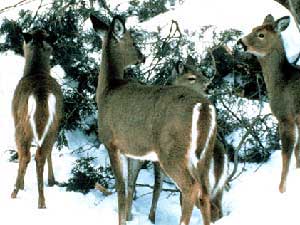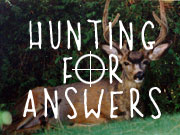Wisconsin's response to CWD evaluated
April 23, 2003
 |
| A herd of white-tailed deer in Wisconsin. DNR officials face scrutiny this week for their handling of the CWD crisis in Wisconsin. (Photo courtesy of Wisconsin DNR) |
Rochester, Minn. — In the past 13 months, hunters and sharpshooters have killed tens of thousands of white-tailed deer in Wisconsin. The largest numbers of deer were taken in what's known as the eradication zone, a four-county region in southwestern Wisconsin. That's where chronic wasting disease was first discovered in the state.
But the state's response is prompting criticism. DNR officials and local residents are at odds over what should happen now.
Phil Muehrcke lives on a farm in Iowa County, along the western edge of the eradication zone. He opposes the DNR's strategy for dealing with CWD.
 | |||
"I started out in support of the program, as most people did a year ago," says Muehrcke. "But as things transpired, people I think generally in the zone were progressively turned off by the policy. The people felt they weren't being heard. They would go to meetings and all of the decisions were already made."
Muehrcke says many of the DNR's decisions affect day-to-day life in his community. Suddenly the region is a year-round hunting zone. Muehrcke says everyone is cautious about how they enjoy the outdoors. Parents are worried about letting their kids outside. Some are even concerned about their dogs. Muehrcke says neighbors want more input.
All along, the DNR has argued the best way to control the disease is through quick decisive action. Special hunts began last summer. The DNR says that's the best way to control the disease and maintain a healthy deer herd, which is vital for the state's $1 billion hunting industry.
Hunters killed record numbers of deer in the targeted southwestern counties. All told, the DNR has tested close to 40,000 white-tailed deer statewide. It's considered the largest testing of a wildlife species in history.
 | |||
So far, close to 200 deer have tested positive for CWD, a fatal disease that makes brain and muscle tissue disintegrate. No one's sure how the disease is transmitted, but scientists have a hunch that body fluids like saliva play a key role.
Now, a panel of six nationally-recognized scientists will review the Wisconsin DNR's action plan. The state has come under fire in the past year by some who say there's still a lot that's unknown about the disease. They say killing thousands of deer is irresponsible.
DNR spokesman Greg Mathews says he hopes his department gets a passing grade. Mathews says it could help to boost public support.
"I think part of it is public relations," says Mathews. "We are bringing people in that are experts from across North America, and we're looking for their stamp of approval. People say we're not operating on a scientific basis, and that's pure hogwash."
|
A lot of us, not only the DNR but also people who live in the eradication zone, we're really looking for a break because this has been very, very intense.
- Greg Mathews, Wisconsin DNR |
In Minnesota, state wildlife officials tested roughly 5,000 deer during an extended fall hunt. So far there's no sign of chronic wasting disease in Minnesota's wild deer. But at least two farmed elk in the state have tested positive for the disease. If CWD does turn up in the wild, Minnesota's DNR would follow a similar approach to Wisconsin.
In South Dakota, the disease has been found in both wild and captive herds, but the state has taken a low-key approach. They prefer to watch and learn. As a result, scientists are extensively tracking animals in Wind Cave National Park.
Wisconsin wildlife officials say battling chronic wasting disease has taken its toll. The DNR's Greg Mathews says he's been yelled at and called names more than once. Now he hopes to sit back and catch his breath.
"A lot of us, not only the DNR but also people who live in the eradication zone, we're really looking for a break because this has been very, very intense," says Mathews.
The break may come this summer. Unlike last summer, the Wisconsin DNR won't host special hunts in the eradication zone.
But there's another controversy brewing. The DNR wants to ban baiting and feeding of deer statewide. It's an unpopular proposition that's put the DNR and its flagging credibility back in the hot seat. A Wisconsin legislative committee will vote on the ban this week.
|
News Headlines
|
Related Subjects
|

